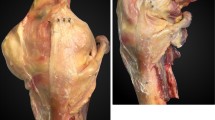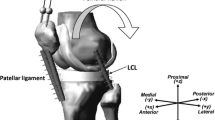Abstract
Purpose
The knowledge of the function of the collateral ligaments—i.e., superficial medial collateral ligament (sMCL), deep medial collateral ligament (dMCL) and lateral collateral ligament (LCL)—in the entire range of knee flexion is important for soft tissue balance during total knee arthroplasty (TKA). The objective of this study was to investigate the length changes of different portions (anterior, middle and posterior) of the sMCL, dMCL and LCL during in vivo weightbearing flexion from full extension to maximal knee flexion.
Methods
Using a dual fluoroscopic imaging system, eight healthy knees were imaged while performing a lunge from full extension to maximal flexion. The length changes of each portion of the collateral ligaments were measured along the flexion path of the knee.
Results
All anterior portions of the collateral ligaments were shown to have increasing length with flexion except that of the sMCL, which showed a reduction in length at high flexion. The middle portions showed minimal change in lengths except that of the sMCL, which showed a consistent reduction in length with flexion. All posterior portions showed reduction in lengths with flexion.
Conclusions
These data indicated that every portion of the ligaments may play important roles in knee stability at different knee flexion range. The soft tissue releasing during TKA may need to consider the function of the ligament portions along the entire flexion path including maximum flexion.
Level of evidence
III.




Similar content being viewed by others
References
Amiri S, Cooke TD, Wyss UP (2011) A multiple-bundle model to characterize the mechanical behavior of the cruciate ligaments. Knee 18:34–41
Bergamini E, Pillet H, Hausselle J, Thoreux P, Guerard S, Camomilla V, Cappozzo A, Skalli W (2011) Tibio-femoral joint constraints for bone pose estimation during movement using multi-body optimization. Gait Posture 33:706–711
Blankevoort L, Huiskes R (1991) Ligament-bone interaction in a three-dimensional model of the knee. J Biomech Eng 113:263–269
DeFrate LE, Gill TJ, Li G (2004) In vivo function of the posterior cruciate ligament during weightbearing knee flexion. Am J Sports Med 32:1923–1928
DeFrate LE, Papannagari R, Gill TJ, Moses JM, Pathare NP, Li G (2006) The 6 degrees of freedom kinematics of the knee after anterior cruciate ligament deficiency: an in vivo imaging analysis. Am J Sports Med 34:1240–1246
Delport H, Labey L, De Corte R, Innocenti B, Vander Sloten J, Bellemans J (2013) Collateral ligament strains during knee joint laxity evaluation before and after TKA. Clin Biomech (Bristol, Avon) 28:777–782
Engh GA (2003) The difficult knee: severe varus and valgus. Clin Orthop Relat Res (416):58–63
Ghosh KM, Merican AM, Iranpour F, Deehan DJ, Amis AA (2012) Length-change patterns of the collateral ligaments after total knee arthroplasty. Knee Surg Sports Traumatol Arthrosc 20:1349–1356
Halewood C, Risebury M, Thomas NP, Amis AA (2014) Kinematic behaviour and soft tissue management in guided motion total knee replacement. Knee Surg Sports Traumatol Arthrosc. doi:10.1007/s00167-014-2933-5
Handrigan G, Hue O, Simoneau M, Corbeil P, Marceau P, Marceau S, Tremblay A, Teasdale N (2010) Weight loss and muscular strength affect static balance control. Int J Obes (Lond) 34:936–942
Hoshino Y, Wang JH, Lorenz S, Fu FH, Tashman S (2012) The effect of distal femur bony morphology on in vivo knee translational and rotational kinematics. Knee Surg Sports Traumatol Arthrosc 20:1331–1338
Hosseini A, Gill TJ, Li G (2009) In vivo anterior cruciate ligament elongation in response to axial tibial loads. J Orthop Sci 14:298–306
Jordan SS, DeFrate LE, Nha KW, Papannagari R, Gill TJ, Li G (2007) The in vivo kinematics of the anteromedial and posterolateral bundles of the anterior cruciate ligament during weightbearing knee flexion. Am J Sports Med 35:547–554
Kim YH, Choi Y, Kim JS (2009) Range of motion of standard and high-flexion posterior cruciate-retaining total knee prostheses a prospective randomized study. J Bone Joint Surg Am 91:1874–1881
Kim YH, Choi Y, Kwon OR, Kim JS (2009) Functional outcome and range of motion of high-flexion posterior cruciate-retaining and high-flexion posterior cruciate-substituting total knee prostheses. A prospective, randomized study. J Bone Joint Surg Am 91:753–760
Konig C, Matziolis G, Sharenkov A, Taylor WR, Perka C, Duda GN, Heller MO (2011) Collateral ligament length change patterns after joint line elevation may not explain midflexion instability following TKA. Med Eng Phys 33:1303–1308
Li G, DeFrate LE, Sun H, Gill TJ (2004) In vivo elongation of the anterior cruciate ligament and posterior cruciate ligament during knee flexion. Am J Sports Med 32:1415–1420
Li G, Wuerz TH, DeFrate LE (2004) Feasibility of using orthogonal fluoroscopic images to measure in vivo joint kinematics. J Biomech Eng 126:314–318
Li G, Zayontz S, Most E, DeFrate LE, Suggs JF, Rubash HE (2004) In situ forces of the anterior and posterior cruciate ligaments in high knee flexion: an in vitro investigation. J Orthop Res 22:293–297
Li N, Tan Y, Deng Y, Chen L (2014) Posterior cruciate-retaining versus posterior stabilized total knee arthroplasty: a meta-analysis of randomized controlled trials. Knee Surg Sports Traumatol Arthrosc 22(3):556–564
Lionberger DR, Eggers MD, Brewer KE, Fang L (2012) Improved knee flexion following high-flexion total knee arthroplasty. J Orthop Surg Res 7:22
Liu F, Gadikota HR, Kozanek M, Hosseini A, Yue B, Gill TJ, Rubash HE, Li G (2011) In vivo length patterns of the medial collateral ligament during the stance phase of gait. Knee Surg Sports Traumatol Arthrosc 19:719–727
Liu F, Yue B, Gadikota HR, Kozanek M, Liu W, Gill TJ, Rubash HE, Li G (2010) Morphology of the medial collateral ligament of the knee. J Orthop Surg Res 5:69
Luo SX, Zhao JM, Su W, Li XF, Dong GF (2012) Posterior cruciate substituting versus posterior cruciate retaining total knee arthroplasty prostheses: a meta-analysis. Knee 19:246–252
Mendiguchia J, Ford KR, Quatman CE, Alentorn-Geli E, Hewett TE (2011) Sex differences in proximal control of the knee joint. Sports Med 41:541–557
Mihalko WM, Whiteside LA (2003) Bone resection and ligament treatment for flexion contracture in knee arthroplasty. Clin Orthop Relat Res 406:141–147
Padua DA, Carcia CR, Arnold BL, Granata KP (2005) Gender differences in leg stiffness and stiffness recruitment strategy during two-legged hopping. J Mot Behav 37:111–125
Page Glave A, Di Brezzo R, Applegate DK, Olson JM (2014) The effects of obesity classification method on select kinematic gait variables in adult females. J Sports Med Phys Fit 54:197–202
Papannagari R, DeFrate LE, Nha KW, Moses JM, Moussa M, Gill TJ, Li G (2007) Function of posterior cruciate ligament bundles during in vivo knee flexion. Am J Sports Med 35:1507–1512
Park SE, DeFrate LE, Suggs JF, Gill TJ, Rubash HE, Li G (2005) The change in length of the medial and lateral collateral ligaments during in vivo knee flexion. Knee 12:377–382
Park SE, DeFrate LE, Suggs JF, Gill TJ, Rubash HE, Li G (2006) Erratum to “The change in length of the medial and lateral collateral ligaments during in vivo knee flexion”. Knee 13:77–82
Sasanuma H, Sekiya H, Takatoku K, Takada H, Sugimoto N (2010) Evaluation of soft-tissue balance during total knee arthroplasty. J Orthop Surg (Hong Kong) 18:26–30
Schirm AC, Jeffcote BO, Nicholls RL, Jakob H, Kuster MS (2011) Sensitivity of knee soft-tissues to surgical technique in total knee arthroplasty. Knee 18:180–184
Sumino T, Gadikota HR, Varadarajan KM, Kwon YM, Rubash HE, Li G (2011) Do high flexion posterior stabilised total knee arthroplasty designs increase knee flexion? A meta analysis. Int Orthop 35:1309–1319
Yang Z, Wickwire AC, Debski RE (2010) Development of a subject-specific model to predict the forces in the knee ligaments at high flexion angles. Med Biol Eng Comput 48:1077–1085
Acknowledgments
The authors gratefully acknowledge the support of the National Institutes of Health (R01 AR055612) and the scholarship provided by the Chinese PLA General Hospital.
Conflict of interest
There is no potential conflict of interest to declare.
Author information
Authors and Affiliations
Corresponding author
Rights and permissions
About this article
Cite this article
Hosseini, A., Qi, W., Tsai, TY. et al. In vivo length change patterns of the medial and lateral collateral ligaments along the flexion path of the knee. Knee Surg Sports Traumatol Arthrosc 23, 3055–3061 (2015). https://doi.org/10.1007/s00167-014-3306-9
Received:
Accepted:
Published:
Issue Date:
DOI: https://doi.org/10.1007/s00167-014-3306-9




